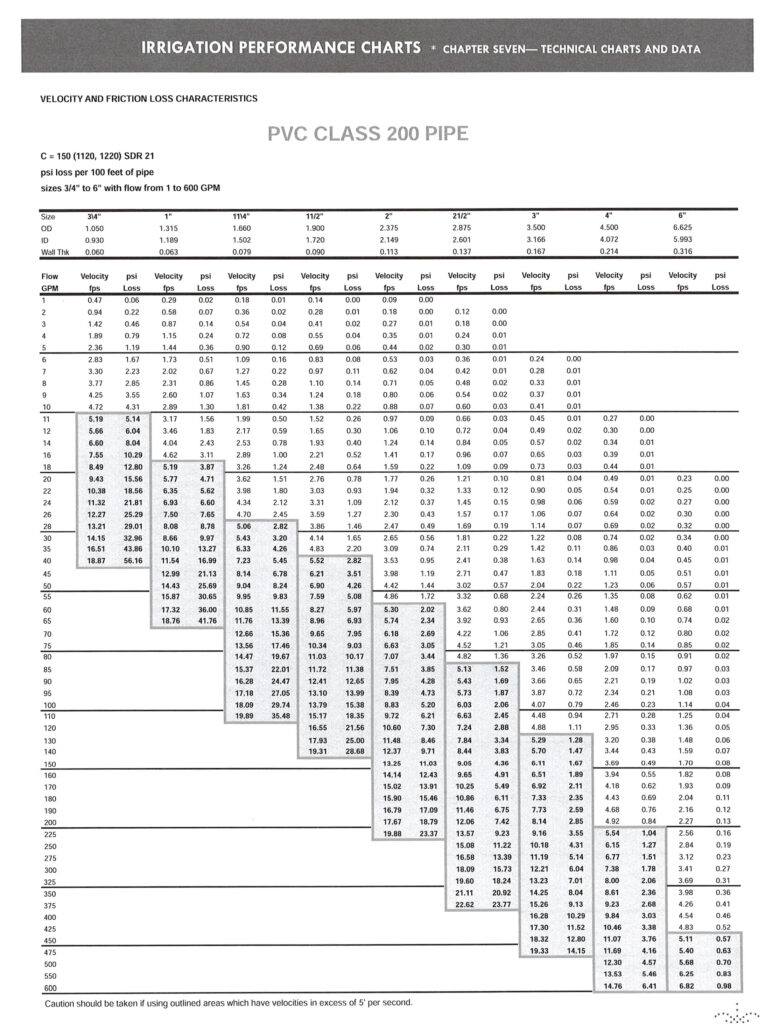PVC Pipe Sizing Guide – Efficient Irrigation Design
Properly sizing PVC pipes is crucial for designing an efficient and effective irrigation system. The Class 200 PVC Pipe Sizing Guide offers a detailed understanding of flow rates, pipe sizes, velocity, and pressure loss, enabling irrigators to select the appropriate pipe size for any given flow requirement. This guide simplifies the process of maintaining optimal water delivery and minimizing friction loss across the system.

How to Use the PVC Pipe Sizing Guide
- Determine the Desired Flow Rate:
Start by identifying the total Gallons Per Minute (GPM) needed for your irrigation system. For instance, if your system uses 75 GPM, locate this value on the left side of the chart. - Select the Appropriate Pipe Size:
Cross-reference the flow rate with the corresponding pipe size column (e.g., 1 ¼”, 1 ½”, 2”).- For 75 GPM, the chart shows that 1 ¼” pipe is required for Class 200 PVC to handle this flow while maintaining safe velocity and pressure loss.
- Step Down Pipe Sizes:
As you move further along the system and fewer sprinkler heads need to be supplied, the total GPM reduces. This allows you to step down to a smaller pipe size, optimizing velocity while reducing costs:- Example: If your heads use 3.0 GPM each, after plumbing four heads, the flow reduces to 63 GPM, allowing you to switch to 1” pipe.
- Monitor Velocity:
Areas outlined in the chart warn against exceeding a velocity of 5 feet per second, which can lead to pipe damage and reduced system efficiency. Always select a pipe size that maintains safe velocities. - Consider Pressure Loss:
For longer pipe runs, refer to the PSI Loss column to ensure your system maintains adequate pressure for proper sprinkler performance.
FAQs About PVC Pipe Sizing
1. What is Class 200 PVC, and why is it used for irrigation?
Class 200 PVC pipe is a lightweight, cost-effective material commonly used in irrigation systems. Unlike Schedule 40 pipe, Class 200 PVC offers sufficient strength for irrigation needs while being easier to handle and install.
2. How do I decide when to step down pipe sizes?
Pipe size reductions occur when the total GPM decreases as water is distributed to sprinkler heads or emitters. Use the chart to match the reduced flow rate with the next appropriate pipe size.
3. Why is velocity important in pipe sizing?
Excessive velocity (above 5 feet per second) can cause wear and tear on pipes, leading to leaks or bursts. Keeping velocity within safe limits ensures the longevity and efficiency of the system.
4. What happens if I oversize or undersize the pipe?
- Oversized pipes: Lead to slower velocities and unnecessary material costs.
- Undersized pipes: Increase velocity and pressure loss, which may result in uneven water distribution or pipe damage.
5. Can I use this chart for all types of PVC pipe?
This chart is specific to Class 200 PVC. Other classes or schedules (e.g., Schedule 40) may have different pressure and flow characteristics, so consult the appropriate chart for your specific pipe type.
6. How does pipe length impact the choice of pipe size?
Longer runs result in greater pressure loss. Refer to the PSI Loss column to ensure the selected pipe size can maintain sufficient pressure over the required distance.
Tips for Optimizing Irrigation Systems Using the Chart
- Plan Your System Layout: Map out your sprinkler heads, zones, and flow requirements before selecting pipe sizes.
- Start with the Largest Pipe: Begin with the pipe size required for the total flow rate and step down progressively as flow decreases.
- Check Manufacturer Guidelines: Ensure that the selected pipe sizes align with the specifications of your sprinkler heads or emitters.
- Consider Friction Loss: For systems with long runs or many turns, opt for a slightly larger pipe size to compensate for additional friction loss.
By effectively utilizing the PVC Pipe Sizing Guide, you can design an irrigation system that delivers consistent water flow, minimizes waste, and ensures the durability of your piping network. Proper sizing leads to cost savings and optimal performance, making it a key step in any irrigation project.